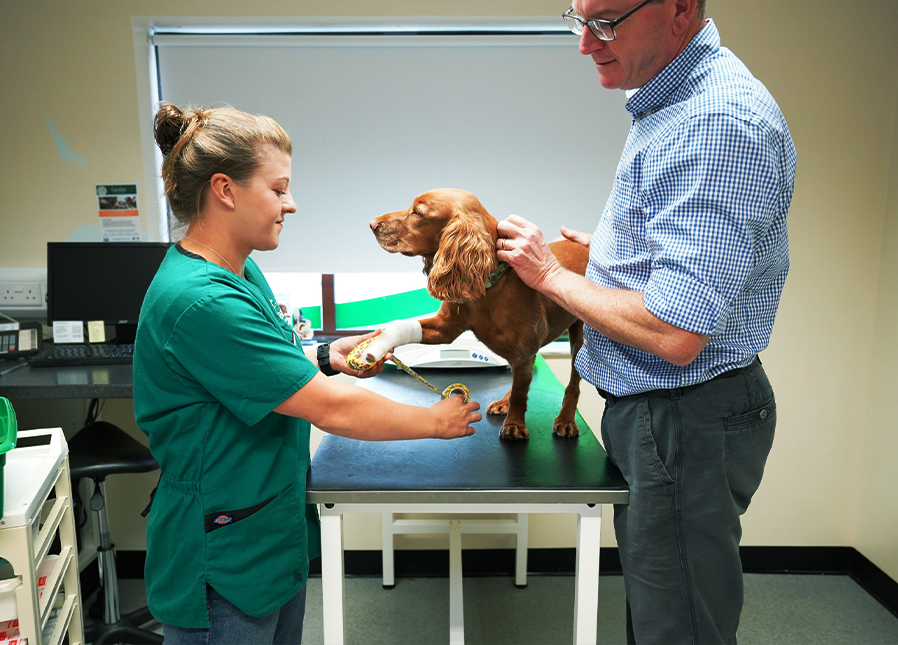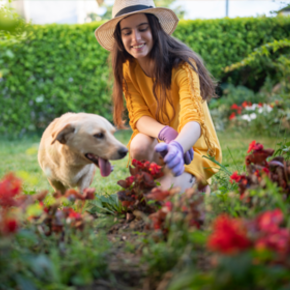
The sun is out, everything is in flower, and everyone has come out of hibernation: gardening season has begun! While this is a lovely time of year to spend with your pet, there are potentially poisonous plants in your garden that will affect cats and dogs. At Garston Vets, we can assist you with pet-proofing your garden by providing a list of common garden plants that are toxic to pets. Read on to learn more about common garden plants you need to look out for and the symptoms of plant poisoning.
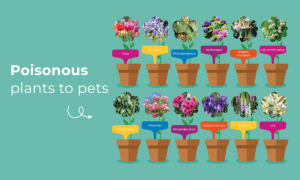
See below for 12 poisonous plants to look out for and the symptoms of poisoning in your cat or dog.
Hydrangea
Signs and symptoms of hydrangea poisoning:
- Vomiting
- Lethargy
- Diarrhoea.
If you suspect your dog has ingested any part of a hydrangea plant, it’s crucial to contact your vet immediately. The earlier treatment is initiated, the better the chances of a full recovery. Early intervention can involve inducing vomiting, administering activated charcoal to absorb toxins, and providing supportive care to manage symptoms and prevent complications.
Lilies
Signs and symptoms of lily poisoning:
- Vomiting
- Not eating.
- Drooling
- Drinking or peeing more
- Twitching, seizures or sudden death
Every part of the lily, including the pollen is very poisonous to cats. Seek veterinary advice immediately if you think your cat has come in contact with this plant. To prevent lily poisoning, it is recommended to remove cut lilies from flower arrangements in the home.
Contact us immediately if you notice any of the above behaviours after your pet has consumed lilies or has lily poisoning.
Lily of the valley
Lily of the valley is one of the most poisonous plants to cats and dogs. The plant’s bulb, roots, stems, leaves, blooms and berries are all poisonous.
Signs and symptoms of lily of the valley plant poisoning
- Diarrhoea
- Vomiting
- Blood in the stool
- Discomfort in the abdomen.
If you think your pet may have eaten any part of the lily of the valley plant, contact your nearest vet immediately.
Autumn Crocus
The autumn crocus is toxic in all parts, but particularly in the bulb, blooms and seeds. Autumn crocus contains tropane alkaloids, which are extremely poisonous to dogs and can cause serious renal issues or even organ failure.
Signs and symptoms of autumn crocus poisoning:
- Burning in the mouth
- Increased salivation
- Thirst
- Difficulty swallowing
- Stomach pain
- Diarrhoea
- Blood in urine or failure to pass urine.
Call us immediately if you believe your pet has swallowed an autumn crocus. Consider removing any of the remaining plant from your home or outdoor areas to prevent further exposure to your pet once your pet has received medical attention.
Oleander
Poisoning Symptoms after Oleander Consumption:
- Diarrhoea
- Elevated heart rate
- Drowsiness
- Seizures or lack of consciousness.
When dogs swallow oleanders, they need to be treated by a vet as soon as possible.
Rhododendron
These gorgeous blooming plants surround many homes; however, it’s very toxic to pets! All parts of the rhododendron plant are toxic for dogs. The rhododendron plant’s leaves are the most harmful, although the flowers and nectar can also be dangerous.
Signs and symptoms of Rhododendron Poisoning
- Gastrointestinal upset
- Weakness
- Paralysis
- Abnormal heart rhythms.
If your pet consumes large doses of this plant, it can be fatal. We advise that you seek veterinary care as soon as possible if you think your pet has consumed this plant.
Angel’s trumpets
Many people own this plant without realising how harmful it is to their pets since it produces beautiful blooms. While most pets are deterred from nibbling on the leaves by their strong odour, some creatures are not.
Signs and symptoms of poisoning include:
- Behavioural changes
- Disorientation
- Dilated pupils
- Hyperthermia
- Loss of appetite
- Change in heart rate
- Change in respiratory rate.
We advise immediate veterinary care if your pet has ingested this plant.
Bluebells
Bluebells are a spring favourite and is a common flower that you may find on woodland walks, in your garden and even on the sides of the road. Bluebells contain a toxin that affects the heart, and are poisonous to dogs.
Signs and symptoms of bluebell poisoning:
- Stomach pain
- Dermatitis and irritation of the skin
- Vomiting
- Diarrhoea
- Drooling
- Trembling
- Lethargy
- Reduced heart rate.
Foxgloves
All parts of the foxgloves plant are poisonous to dogs, cats, and even humans. These toxins, called cardiac glycoside toxins, affect the heart by disrupting its internal balance.
Signs and symptoms of foxglove poisoning:
- Nausea
- Tremors
- Collapse.
If you believe your dog has ingested or chewed a piece of this plant, treat it as a medical emergency and contact your vet as soon as possible. Foxglove poisoning lacks an antidote; thus, supportive therapy becomes the primary treatment approach.
Garden Hazards for Pets
To ensure that your pets don’t try to eat or nibble on your home plants while you’re away, it’s best to keep them out of reach. Additionally, keep an eye on your dog to make sure they haven’t discovered any plants that might endanger them when they’re on walks or in the garden. Keeping them on a lead would make this easier when walking them.
Plants that are Safe for Your Pets
Shrubs
- Black Hawthorn
- Chaparral
- Crimson Bottlebush
- Magnolia Bush
- Mulberry Bush
- Rose.
Trees
- Big shellbark hickory
- Bitter pecan
- Bottle palm
- Carob tree
- Figleaf palm
- Hemlock tree
- Iron tree
- Japanese aralia
- Mockernut hickory
- Mulberry tree
- Pupleosier willow
- Red maple
- Silver bell tree
- Tree cactus
- Tulip poplar.
Flowers
- African violet
- Bromeliads
- Creeping zinnia
- Gerbera daisy
- Lipstick plant
- Petunia
- Phalaenopsis orchid
- Zinnia
Houseplants
- American rubber plant (Common names: pepper face, baby rubber plant)
- Blue echeveria, a succulent (Common names: maroon chenille, painted lady, copper rose, wax rosette, plush plant, “hen and chicks”)
- Boston fern
- Cast iron plant
- Christmas cactus
- Donkey’s tail, a succulent
- Parlor palm
- Spider plant
- Swedish ivy.
Learn more about other dangers for your pet, with our blogs about chocolate poisoning here and our post on the dangers of conkers here for more information on things to keep out of your pet’s reach!

From skin irritations to digestive issues, understanding and addressing common allergies in dogs is essential for ensuring their wellbeing. In this blog, we delve into the world of canine allergies, exploring their types, symptoms and effective management strategies.
Food Allergies in Dogs
Food allergies can manifest through various symptoms, including gastrointestinal issues or skin problems. Common food allergens for dogs include proteins such as beef, chicken, dairy and grains like wheat and soy. Symptoms of food allergies in dogs may include itching, redness, swelling, ear infections, vomiting, diarrhoea or changes in bowel habits. It’s essential to distinguish between food allergies and food intolerances, as they may present similar symptoms but have different underlying mechanisms.
Your vet may recommend hypoallergenic or prescription diets that exclude the identified allergens. In some cases, they might also suggest the use of supplements like omega-3 fatty acids to promote skin health. It’s important for dog owners to adhere to the prescribed diet to effectively manage and alleviate food allergies. Speak to a vet at Garston for advice on the best food for your dog and what to avoid, as well as a proper diagnosis of food allergies.
Contact Allergies
Contact allergies in dogs, also known as contact dermatitis, occur when a dog’s skin reacts adversely to certain substances it comes into direct contact with. These substances, called allergens, can cause irritation and inflammation on the skin. Common sources of contact allergies in dogs include certain plants, chemicals, cleaning agents, fabrics and materials. Should your canine companion be allergic to certain materials, skin irritation and itching will manifest at the sites of contact, often the feet and stomach. When the allergen is identified and removed, the issue is often resolved, however systemic or topical therapies could be necessary. Allergies caused by contact could be more common in certain seasons of the year, impacted by your pet’s environment. Pollen, dust and certain plants can cause irritation.
If you suspect your dog has contact allergies, it is advisable to consult with a nurse or vet for a check-up to discuss this, which may lead to a tailored treatment plan. Additionally, preventive measures such as avoiding known allergens and using hypoallergenic products can help manage and reduce the likelihood of contact allergies in dogs.
Book an allergy appointment with us.
Flea Allergies
An insect bite allergy is an intensified inflammatory reaction to the bite or sting of an insect. Sensitive dogs may experience this allergic response from arachnids like spiders and ticks, as well as insects such as fleas, blackflies, deerflies, horseflies, mosquitoes, ants, bees, hornets, and wasps. The most prevalent insect allergen in dogs that causes flea allergy dermatitis (FAD) is flea saliva. Flea bites cause modest local irritation in most dogs. A single bite will cause local itching. Consulting with a nurse at Garston Vets can offer guidance on safeguarding your dog and other pets against fleas.
In situations where rigorous flea control is challenging or when dealing with intense itching, your vet might recommend antihistamines or corticosteroids (steroids) to mitigate the acute allergic reaction and provide immediate relief.
Learn more about flea and worming treatment for your dog.
Diagnosing Allergies in Dogs
Diagnosing flea allergy dermatitis is typically straightforward. The identification of fleas on your dog’s body and the application of a flea-killing product to prevent bites are commonly used for diagnosis. It is also important that environmental control of fleas is done during this time to help reduce the ongoing flea infestation.
If allergies are suspected, your vet may suggest specific tests to identify the allergen responsible for the reaction. It’s important to note that determining the exact cause of an allergy through testing may not always be feasible.
Treating Allergies in Dogs
The optimal approach to managing an allergy involves avoiding the trigger and allergen, though this may not always be feasible. The specific treatment method varies based on the type of allergy affecting your dog. For instance, addressing flea allergy dermatitis entails eliminating the fleas, while managing a food allergy or intolerance necessitates a dietary change.
We will recommend different treatments depending on the cause and severity of your dog’s allergic reaction. For hives, antihistamines, cortisones or medicated shampoos may be recommended. In the case of food allergies, suggestions might include incorporating fish oil or other Omega-3 fatty acid supplements. Skin allergies may be addressed with vet-prescribed anti-inflammatory wipes or soothing shampoo to alleviate irritation.
Depending on the cause and severity of your dog’s allergic reaction, we will examine your pet and recommend the best treatment plan for them. In addition to any lifestyle changes that might be necessary, we may also prescribe an allergy relief medication for your dog that will help control the signs associated with the allergic reaction, such as itching and any secondary skin infections that might have developed as a result of the irritant.
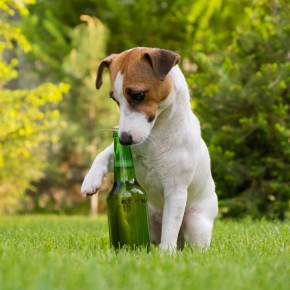
As the days grow longer and the temperatures rise, many dog owners in Wiltshire and Somerset find themselves drawn to the outdoors, eager to spruce up their gardens and enjoy the beauty of spring. While gardening can be a delightful activity, it’s crucial to consider the safety of our furry companions, especially our inquisitive dogs.
Garston Vets have some essential spring garden safety tips to ensure a hazard-free environment for your canine companion. Remember, if you ever encounter an emergency, don’t hesitate to call our vet practice immediately on 01373 452225.
See all our contact information
What to watch out for in your garden
- Pet-Friendly Plants: Spring often brings an array of blooming plants, but not all of them are safe for our canine friends. Some common garden plants, such as azaleas, tulips, and daffodils, can be toxic to dogs if ingested. Research the plants in your garden and remove any that may pose a risk. Garston Vets’ advice is to choose pet-friendly alternatives like marigolds, sunflowers, or snapdragons to add colour without risking your dog’s health.
- Fertilisers and Mulch: As you prepare your garden for the growing season, be cautious with fertilisers and mulch. Many commercial fertilisers contain chemicals that can be harmful if ingested by dogs. Choose pet-safe fertilisers and mulch options to minimise the risk. Additionally, keep your dog away from freshly treated areas until the products have been absorbed or watered in to prevent accidental ingestion.
- Pesticides and Herbicides: While pests and weeds may pose challenges in the garden, the use of pesticides and herbicides requires careful consideration. These chemicals can be toxic to dogs, both through direct contact and ingestion. Our team recommends opting for pet-safe alternatives or natural pest control methods to protect your garden without compromising your dog’s well-being. If you must use chemical products, ensure they are thoroughly dry or absorbed before allowing your dog access to the treated areas.
- Secure Fencing: Spring is a time when many dogs in Wiltshire and Somerset will become more active outdoors and eager to explore. Ensure that your garden is securely fenced to prevent your dog from wandering off or encountering potential dangers beyond your property. Regularly inspect the fence for any gaps or damage that may compromise its integrity. A secure fence not only keeps your dog safe but also provides them with a designated space to enjoy the outdoors.
- Watch Out for Sharp Objects: As you engage in gardening activities, be mindful of sharp tools and objects that may pose a risk to your dog’s paws or mouth. Store gardening tools safely and keep them out of your dog’s reach. Check the garden for any stray nails, broken glass, or sharp objects that could cause injuries. A tidy and well-maintained garden ensures a safer environment for your curious canine companion.
Spring is a wonderful time to cultivate a beautiful and pet-friendly garden. By following Garston Vets’ spring garden safety tips, you can create a space where your inquisitive dog can enjoy the outdoors without encountering potential hazards. Remember, your pet’s safety is our top priority. If you ever find yourself in an emergency situation, don’t hesitate to call our vet practice immediately on 01373 452225.
Go on, share our article and these tips with your friends & family and help us ensure a happy and healthy springtime for dogs in Wiltshire and Somerset and beyond!
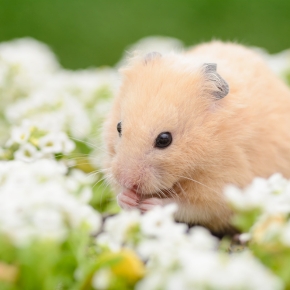
What better way to celebrate the arrival of spring in Wiltshire and Somerset than by growing an edible garden for your small furry pets? Whether you have rabbits, guinea pigs, hamsters, gerbils or other small pets, cultivating an edible garden not only provides them with fresh and nutritious treats but can also offers a rewarding and interactive experience for both pet and owner.
In this article, Garston Vets’ nursing team share the benefits of growing an edible garden for your pet, as well as tips on which foods to plant and what you’ll need to get started. Plus, download our step-by-step guide on how to:
Grow an Edible Garden for Small Furry Pets
Choosing the right edible garden
When it comes to edible gardens for small pets, there are two ways you can go. Garston Vets’ team of nurses think you’ll probably end up wanting to build both!
Option 1 – Grow an edible garden for you to harvest
Creating an area in your Wiltshire and Somerset garden to grow your own fruit & vegetables that can supplement your pet’s diet is a win-win on many levels; home-grown foods are super fresh and full of essential nutrients, they are free from chemicals (when you don’t user chemical fertiliser or pesticides), often cheaper than buying from the shop, and there’s no plastic wrappers to throw away. Plus, gardening can be fun and rewarding!
Our nurses can recommend several common vegetables that you can grow in your garden which are suitable for rabbits, guinea pigs, hamsters, and gerbils. These include:
- Carrots: Rich in vitamin A and provide essential nutrients for these small pets.
- Lettuce: Leafy greens (e.g. romaine, green leaf & red leaf lettuce) are safe in moderation.
- Kale: High in vitamins and minerals; give in moderation due to its calcium content.
- Spinach: Give in moderation due to its oxalic acid content.
- Broccoli: Rich in vitamins & minerals, including vitamin C, give in small amounts as a treat.
- Bell Peppers: Provide essential nutrients such as vitamin C, can be fed raw or cooked.
- Cucumber: Low in calories and provides essential hydration for these small pets.
- Zucchini: Low in calories, provides essential vitamins & minerals, can be fed raw or cooked.
When feeding fresh vegetables from your garden to rabbits, guinea pigs, hamsters, and gerbils, it’s essential to wash them thoroughly and provide them in appropriate portion sizes. Introduce new foods gradually and monitor your pet for any adverse reactions. Additionally, talk to our Wiltshire and Somerset nurses about providing a balanced diet tailored for your small pet – get in touch.
Option 2 – Grow an edible garden for your pet to forage in
You can create an interactive and enriching experience for your pet by building an edible garden they can forage in, which will mimic their natural wild behaviours.
The materials you will need will depend on the type of small furry pet you have. For rabbits and guinea pigs you’ll need a large plant pot or trough that can be moved in and out of their hutch easily, or placed in an outdoor run that isn’t accessible all the time. For hamsters and gerbils, you’ll need a second cage (we suggest checking online for second hand ones) that you can place a pet-safe plastic tray inside. It’s wise not to give your pet access to their garden all the time so they don’t eat everything in one sitting!
It’s Gardening Time!
You’ll need to remember that ‘gardening time’ for your small furry pet will be messy – they will dig, rip up, throw things out and basically undo all your hard work, but they’ll have so much fun doing it! You could make this a weekend fun activity and have a few trays or troughs growing at the same time that you can swap in and out, doing a little maintenance and replanting along the way!
To get you started, Garston Vets’ team of nurses have shared some examples of edibles you can grow, sow, or throw into your planter or tray:
- For rabbits: Mint, parsley, basil, dill, and carrot tops.
- For guinea pigs: Bell peppers, strawberries, cilantro, and kale.
- For hamsters: Dandelion leaves, sunflower seeds, and small amounts of broccoli.
- For gerbils: Blueberries, cilantro, and small amounts of apple.
For a list of the materials you will need and additional seeds you can buy, plus instructions on how to build your pet’s very own edible garden, download our ‘how to’ guide:
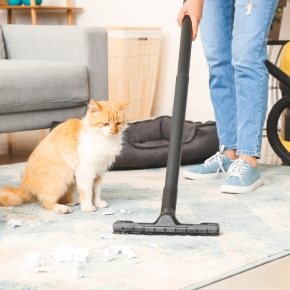
As the vibrant colours of spring begin to bloom in Wiltshire and Somerset, many pet owners turn their attention to spring cleaning. While decluttering and freshening up your living space can be invigorating, it’s essential to be mindful of potential hazards for our feline friends.
Cats are naturally curious creatures, and as you embark on your spring-cleaning journey, it’s crucial to create a safe environment for your four-legged family members. In this article, we’ll explore some common indoor hazards and learn how to ensure your curious cat stays happy and healthy with tips from the veterinary team at Garston Vets.
Contact us with your cat concerns
Cat safety tips for a thorough spring clean
Know which cleaning products are toxic to cats
Spring cleaning often involves an array of cleaning products, many of which can be toxic to cats. Household cleaners, bleach, and disinfectants may contain chemicals that can be harmful if ingested or if they come into contact with your cat’s skin. As a general rule of thumb, any products with a hazard warning on aren’t safe for cats. When using these products, ensure proper ventilation, and keep your feline friend in a separate, well-ventilated area until surfaces are dry. Our vets in Wiltshire and Somerset recommend that cat owners consider using pet-safe cleaning alternatives or thoroughly rinsing and drying surfaces afterwards.
Can you recommend any pet-safe cleaning products? Help other Wiltshire and Somerset cat owners and share them on our Facebook page.
Keep cats safe by windows & balconies
With the arrival of warmer weather in Wiltshire and Somerset and when you’re using chemicals to clean, you’ll probably want to open windows and let the fresh air in. However, open windows and balconies can pose a danger to cats, especially those with a penchant for exploring. Ensure that any external openings aren’t big enough for your cat to get out of, or they are securely screened to prevent accidental falls or escapes. You may want to create a cozy spot in the room you’ll be tackling last to keep them away from cleaning chemicals and smells.
Manage loose cords and string
Spring cleaning often involves reorganising and tidying up, which can lead to the discovery of loose cords and strings. Cats are notorious for playing with anything that dangles, but these items can pose a choking hazard if ingested or they could get tangled in them. Top tips from the team at Garston Vets are:
- Secure loose cords or tuck them away to prevent your cat from playing with them.
- Provide safe alternatives, such as interactive toys, to keep your cat entertained & engaged.
Check hidden spaces
Cats love to explore nooks and crannies, especially when there’s a change in their environment. During spring cleaning, be mindful of potential hiding spots that may become accessible. Check behind furniture, inside cabinets, and under appliances to ensure your cat can’t access tight spaces where they may get stuck or find hazardous materials.
Beware of springtime flowers & plants that are poisonous to cats
When the spring clean is over, you might want to add a touch of nature to your home with some springtime flowers or plants. Beware though, some plants are toxic to cats. Lilies, daffodils, azaleas, and tulips are just a few examples of plants that can be harmful when ingested. The advice from our veterinary team in Wiltshire and Somerset is that you should research the plants in your home and remove any that pose a risk to your cat. You could just opt for pet-friendly flowers like catnip or spider plants instead to brighten up your space without compromising your cat’s safety.
Why not share your favourite cat-friendly plants & flowers on our Facebook page to help other cat owners in Wiltshire and Somerset?
Spring cleaning is an excellent opportunity to refresh your living space, but it’s essential to prioritise your cat’s safety throughout the process. By being mindful of potential hazards such as toxic cleaning products, open windows, loose cords, hidden spaces and harmful plants, you can create a safe and comfortable environment for your curious feline companion.
In an emergency, call us on 01373 452225 right away, or if you have any questions about our article, view all our contact details here.

Celebrate world book day 2024 with us at Garston Vets
Happy World Book Day to our wonderful clients at Garston Vets. Join us as we celebrate our favourite fictional pets. In this article we also explore how we can all take the lessons that we learn from our beloved fictional pets into our everyday lives. Whether you are a fan of the classics such as Wilbur the pig and Stuart Little, or a lover of Bluey and the Australian Heeler family, there is a fictional animal dear to all of us.
From mice to man’s best friend: Caring for pets of any sizes
Some of our favourite books we hold close to our hearts because of the timeless lessons in friendship and care, across a diverse range of different characters. Here at [Insert Clinic Name] we care for a wide variety of pets and their unique needs. This World Book Day, celebrate your love of your favourite pet or animal of any size through the characters of your favourite stories. From dogs, to cats, to smaller furry friends including mice, guinea pigs, reptiles and fish!
10 Pet-related costume ideas for World Book Day
1. Clifford the Big Red Dog: Dress up as Clifford, the beloved giant red dog from the book series by Norman Bridwell.
2. The Cat in the Hat: Emulate the mischievous cat with a tall, striped hat, and a red bowtie, inspired by Dr. Seuss’s iconic character.
3. Peter Rabbit: Transform into the adventurous Peter Rabbit from Beatrix Potter’s classic tales with a blue jacket and rabbit ears.
4. Max from “Where the Wild Things Are”: Wear a wolf suit to become Max, the adventurous young boy from Maurice Sendak’s story.
5. White Rabbit from “Alice’s Adventures in Wonderland”: Create a costume inspired by the White Rabbit, complete with a waistcoat and a pocket watch.
6. Snoopy from “Peanuts”: Don a beagle costume and become the beloved Snoopy, the imaginative pup from Charles M. Schulz’s comic strip.
7. Wilbur from “Charlotte’s Web”: Dress as Wilbur the pig, the main character in E.B. White’s classic novel, complete with pig ears and a pink outfit.
8. Toto from “The Wizard of Oz”: Transform into Dorothy’s loyal dog, Toto, with a dog costume and a small basket to carry.
9. Puss in Boots: Emulate the charming and adventurous Puss in Boots from various fairy tales and the “Shrek” franchise with a stylish outfit and boots.
10. Paddington Bear: A red hat and blue coat is all you need to be instantly recognisable as the marmalade-loving bear from Michael Bond’s classic. These costume ideas allow you to pay homage to famous pet-related characters from literature on World Book Day.
Promoting responsible pet ownership through World Book Day
At the heart of World Book Day is the acknowledgement of storytelling’s impact on how we view the world around us. Whether it’s the misadventures of Curious George or the loyalty of Old Yeller, these stories include lessons in care and compassion of others, including our pets.
Here at Garston Vets we are committed to fostering a deeper understanding and appreciation for pets by providing excellent veterinary care. Our vet practice is accredited within the Royal College of Veterinary Surgeons (RCVS) which means we maintain the highest standards of veterinary care.
Preventative healthcare plays an important role in responsible pet ownership and keeping your pet happy and healthy. Ensure that your pet’s routine treatments are taken care of with our Pet Health for Life plan which includes treatments such as flea, worming and vaccinations.
Once upon a vet visit: Fictional pets that visit vets
Stories have also highlighted the importance of regular veterinary check-ups. Take, for instance, Snowy, the dog from “The Adventures of Tintin” series by Hergé. Snowy is taken to the vet in several of the comic stories, including “The Crab with the Golden Claws”. Snowy is a fictional but relatable companion, who wasn’t too brave to ask for help. Just like Snowy, your furry friend’s well-being is our top priority. Regular check-ups play a crucial role in safeguarding the continued health and happiness of pets like Snowy.
Did you know… Our practice is a cat friendly clinic, which means we put measurements in place to provide a calmer setting for your cat?
Learn about our Cat Friendly Clinics
Celebrating fictional and real-life pets with World Book Day 2024
As we wrap up this article, we have learned that World Book Day is more than just the stories in the books we read, but about celebrating the unique lives and stories of people and animals all around us. It also helps us to think about the stories that our team at Garston Vets creates with each patient, each client, and each member of our veterinary family.
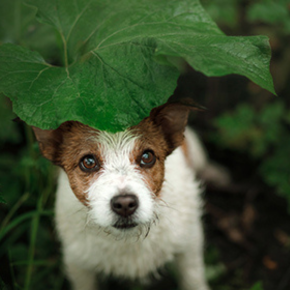
What to do and how you can help a lost or found pet Losing or finding a pet can be a concerning or upsetting time. At Garston Veterinary Group, we’re not just about caring for your pets but also supporting our local community of pet lovers in Wiltshire & Somerset. One of the most distressing experiences for a pet owner is losing or coming across a lost pet in need. This is why our team have put together a guide to support you through what to do if you’ve lost your pet, how to help if you’ve found a lost pet, and steps you can take to prevent such situations in the first place.
Lost your pet? Here’s a step-by-step plan
Losing your pet is a heart-wrenching experience, but there are steps you can take to increase the chances of a reunion:
- Stay calm: Your pet may be frightened, so remaining calm is vital. Many owners who have successfully found their missing dog have waited in the immediate area where their pet has become separated from them and they have actually returned. Call their name and if possible, be patient as it might take a few hours for your dog to come back to you.
- Notify local authorities: Our local dog warden can be contacted on 0300 4560107 and is available 24/7. You should also contact the local animal shelter and veterinary practices. Provide them with a detailed description of your pet, including any distinctive marks or features.
- Create flyers: Distribute flyers with your pet’s photo, contact information, and their last-known location. Post them in and around your local area, pet stores, and online community groups.
- Use social media: Share your pet’s information on local social media platforms, including local lost-and-found pet groups. This can significantly expand your search radius.
- Visit local shelters: Visit nearby animal shelters and rescues regularly. Sometimes, lost and found pets are brought to these facilities
- Don’t give up: Keep searching, and don’t lose hope. Lost pets can often find their way home, even after a few days or weeks.
- Tip when finding your lost pet: Greeting your pet positively when they return is an important part of behaviour training.
Found a lost pet? Here’s How you can help!
What to do if you find a stray animal
Dogs:
- The relevant Local Authority (dog warden) is responsible for all stray or abandoned dogs. You can find the relevant guidance here.
Cats:
- Distinguishing between a stray cat and a feral one can pose a significant challenge. Feral cats reside outdoors, far from human contact, and remain undomesticated. A stray cat may look skinny or underweight, they are usually timid and shy and may come to you in time, whereas a feral cat is most likely to avoid coming up to you as hey tend to live in colonies. Typically, a stray cat will be found roaming around houses and people and even in your garden.
- In the event of encountering a stray cat, your initial step should be to try and locate its owner. You can provide the cat with shelter and nourishment while making efforts to find its owner, but it is essential to have the cat checked for a microchip and search for lost and found listings online beforehand.
- Stray cats can be brought to your local animal shelter or veterinary clinic for a microchip scan to retrieve information about their owner.
If you’re worried about a stray cat’s health, contact the following on their emergency numbers:
· RSPCA (England and Wales) 0300 1234 999
· USPCA (Northern Ireland) 028 3025 1000
· Scottish SCPA (Scotland) 03000 999 999
Identifying a lost pet in Wiltshire & Somerset
Discovering a lost pet on the street can be both concerning and challenging. Here are some steps to safely identify and assist a pet in need, along with a crucial warning about approaching unfamiliar animals:
- Approach cautiously: First and foremost, approach the animal with extreme caution. Keep in mind that the pet may be frightened, disoriented, or possibly injured. Make slow, non-threatening movements, and avoid sudden gestures or loud noises.
- Observe their behaviour: Before attempting to get closer, observe the pet’s behaviour from a safe distance. If the animal appears aggressive, extremely fearful, or demonstrates any signs of illness or injury, it’s crucial to prioritise your safety and not approach further.
- Check for identification: Carefully check for any visible identification, such as tags on a collar. If the pet is wearing a collar, take note of any contact information. However, be aware that unfamiliar animals may react unpredictably, so take great care when trying to examine their collar.
- Offer food and water: If the animal seems approachable and doesn’t show aggressive behaviour, you can offer food and water to help gain their trust. Approach slowly and
- place the offerings near them without making any sudden movements. Keep in mind that a frightened pet may not immediately accept food or water.
- Call for assistance: If you can safely approach the animal and identify an address or phone number on their collar, contact the owner if possible. If the pet appears lost or in distress and you feel comfortable handling them, you can try to keep the pet safe until assistance arrives.
- Alert local authorities: If you are unable to approach the pet safely or the animal is clearly injured or in distress, contact your local council or animal rescue centre.
- Offer temporary care: If you feel comfortable with the pet, provide them with food, water, and shelter while searching for the owner. Ensure the pet is secure and safe.
- Never assume safety: While helping a lost pet can be a compassionate act, it’s crucial to prioritise your safety and the safety of others. Unfamiliar animals, especially when scared or injured, may behave unpredictably. Approach with caution and avoid putting yourself at risk.
- Report a lost or found pet: Use tools such as Animal Search UK, and local groups and pages on social media to spread the word about a lost pet.
- Get their microchip scanned: Your local vet or animal shelter should be able to check the lost pet for a microchip, which they can scan to help identify and then contact the owner. This is why it’s important to microchip your pet and ensure their microchip details are up to date.
Remember that the safety of both the lost pet and the person who finds them is paramount. In some cases, it’s best to let trained professionals handle the situation. Always exercise good judgment when assisting a pet on the street to ensure the well-being of all involved.
Preventative steps to avoid losing your pet
Here at Garston Veterinary Group, our team have put together a list of our best tips for precautions you can take to help avoid losing your pets:
- Secure your garden: Ensure your garden or outdoor areas are escape-proof for dogs. Similarly, you should also regularly check for weak spots in your fences or gates. Consider whether your dog could get over, or even dig their way under.
- Securing your home for indoor cats: If you have an indoor cat, ensure that the doors and windows are always closed to avoid them escaping. · Microchip your pet: Microchipping is a permanent form of identification. Ensure your contact information is up to date with the microchip provider. It is a legal requirement in England for both cats and dogs to have valid and up-to-date microchips to identify them if they ever become lost and found pets.
- Use appropriate collars and tags: Make sure your pet wears a collar with an ID tag containing up-to-date contact information. Additionally, quick-release collars are recommended for cats to reduce risk of injury if the collar gets caught on something whilst they are exploring.
- Training and recall commands: Teach your pet recall commands to ensure they come when called if you want to enjoy time together outdoors without their lead.
- Leash and supervise: Unless you are confident in your dog’s recall ability, you should always leash your dog when outside and supervise them, especially in unfamiliar areas. · Consider having them spayed or castrated: Having your pet neutered reduces the urge to roam and can prevent them from getting lost in the process.
Microchipping your cat is now a legal requirement in England: If you are a cat owner in England, you will be legally required to ensure your cat is microchipped by Saturday 10 June 2024, if it is older than 20 weeks old.
See our preventative care services
How to make your pet more identifiable
By making your pet more identifiable, you increase your chances of a successful reunion. Lost and found pets without any form of identification can often be overlooked as stray pets, so it’s crucial to ensure that they have clear and up-to-date contact information on them. At [Clinic Name], our best recommendations on how you can make your pet more easily trackable and identifiable include:
- Keeping a clear and up-to-date photo of your pet, which shows any unusual coat markings or features that are recognisable to your pet
- Using a GPS collar for real-time tracking
- Considering a reflective or glow-in-the-dark collar for night-time visibility
- Considering colourful or unique collars and accessories for your pet – An animal in a rainbow collar or sparkly pink bandana is a lot more easily identified than one simply wearing a plain collar or none at all.
In times of lost and found pets, the pet-loving community can make a significant difference. By following the suggested steps and taking preventative measures, you can help reunite lost pets with their families and safeguard your own pets from similar ordeals. Together, we can create a safer and more compassionate environment for our beloved companions.
If you have any further questions or concerns, or believe that you have a lost and found pet, please contact us today.
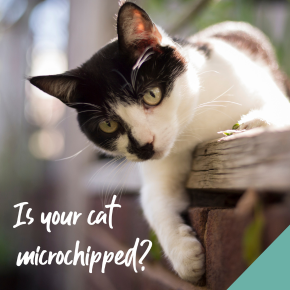
Is your cat microchipped?
If you are a cat owner in England, you will be legally required to ensure your cat is microchipped by Saturday 10 June 2024, if it is older than 20 weeks old, following the Government’s announcements on Monday 13 March 2023. Failure to comply may result in a fine of up to £500. If your cat is already microchipped, it is also part of the law that your details associated with the chip must be up to date.
Why should I microchip my cat?
Microchipping your cat is important because it increases the likelihood of being reunited with your cat if they are lost or stolen. Microchips are a safe and effective method of identification, which makes them more reliable than collars and ID tags that can come off or get lost. Additionally, microchipping does not put your cat at risk of injury or discomfort.
When should you have your cat microchipped?
It is recommended to have your cat microchipped before they go outside for the first time. There is no minimum age requirement for microchipping your cat, but many kittens are microchipped when spayed or neutered while under local anaesthetic. However, the new law requires cats to be microchipped before they are 20 weeks.
Is microchipping an intrusive procedure?
Microchipping your cat is a quick and painless procedure, no more painful than getting an injection. Your cat won’t need any recovery time and is unlikely to experience any discomfort or pain, as they may not even notice the microchip’s presence. The chip is no bigger than a grain of rice and is usually inserted under the skin between their shoulder blades, and you (or your cat) won’t notice it once it’s there.
The importance of microchipping your cat
Microchipping your cat is an important way to identify them and be reunited if you are ever separated. The microchip contains your details as an owner and is stored on a central pet database. While you may never need to use it, having a microchip can give you peace of mind in case of unexpected situations, such as:
- Your cat is lost It’s easily done – even the most careful owners are at risk of their cat running away. It can be scary when a cat goes missing, but don’t worry! It will most likely be taken to a vet or rescue centre, where they will scan for a microchip and contact you if they find a match.
- Your cat is stolen Unfortunately some cats – particularly those of high value – are stolen to order and resold. Without a microchip, you wouldn’t be able to trace them. With a chip, your cat can be identified and brought back home.
- Your cat is in an accident. Outdoor pets, especially cats, are prone to injury, whether fighting with another cat or being involved in an accident. Injured cats found by members of the public are usually taken to a local vet practice, which will treat the cat whilst also trying to track down the owner.
Are your cat’s details up to date?
Updating your contact details is crucial for being easily reachable in case your pet goes missing. Many cats end up not being reunited with their owners because their contact information isn’t up to date. It is now law that your contact details must be up to date.
If your cat is not microchipped yet, please book an appointment online or call our client care team.
For further information about the upcoming compulsory cat microchipping to help reunite lost and stray pets, visit the Government UK website.
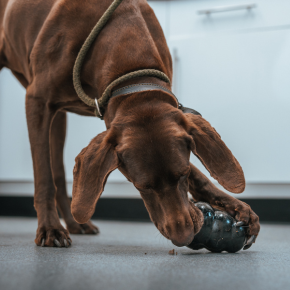
As winter coats the roads with ice, you will often see the flashing orange lights of salt spreaders out and about to make the roads safe. You will also likely see salt being spread on pavements and car parks for the same reason, however, some of it can be difficult to spot.
While this solution is effective for human safety, it poses a hidden danger to our four-legged friends. Road salt, or rock salt, may keep roads and pavements clear and preventing slipping, but its impact on dogs can be quite hazardous.
Contact Garston Veterinary Group on 01373 452225 if you have any concerns about your dog’s health.
What is road salt?
Road salt is typically composed of sodium chloride, calcium chloride, or magnesium chloride. It is used to lower the freezing point of water. When sprinkled on icy roads and paths, it prevents the formation of ice and helps make surfaces safer for vehicles and walkers.
The dangers of road salt for dogs
Paw irritation & dehydration
The most immediate risk for dogs is the irritation road salt can cause to their paws. When dogs walk on salted surfaces, their paw pads can become cracked, dry, and painful. This can lead to discomfort, limping, and difficulty walking.
Road salt is a desiccant, which means it can absorb moisture from a dog’s paws and skin. Extended contact with road salt can lead to dehydration and skin issues.
Oral ingestion
Dogs are known for their inquisitive nature and may lick or chew their paws after walking on salted surfaces. In doing so, they can ingest road salt, which is toxic to dogs when consumed in significant quantities causing:
a) Digestive issues
Ingesting road salt can lead to gastrointestinal upset in dogs. Symptoms may include vomiting, diarrhoea, drooling, and abdominal pain.
b) Salt toxicity
Andy stresses that the most severe risk is salt toxicity, which can occur if a dog consumes a large amount of road salt. This can lead to symptoms such as excessive thirst, tremors, seizures, and, in severe cases, even death.
How to prevent road salt related issues
- Protective Paw Balm: Andy suggests considering using a paw balm or wax to create a protective barrier on your dog’s paw pads before going outside.
- Booties: Dog booties provide excellent protection from road salt, keeping paws dry and safe.
- Avoid Salted Areas: Whenever possible, avoid walking your dog on salted surfaces. Choose areas with minimal salt use.
- Wipe Paws: After walks, wipe your dog’s paws with a damp cloth to remove salt and prevent ingestion.
- Indoor Rinsing: Rinse your dog’s paws with warm water when returning home to remove salt residue.
- Pet-Friendly Salt: If you need to use salt on your property, choose pet-friendly, non-toxic alternatives.
- Supervision: Always supervise your dog when they’re outside, especially around areas treated with road salt.
In conclusion, road salt is essential for human safety during winter, but it poses several risks to dogs. By taking proactive measures to protect your dog’s paws and avoid salted areas, you can ensure their safety and wellbeing during the winter months. Our team recommend that a little extra care can go a long way in keeping your furry companion healthy and happy.

Are you planning on starting 2024 with a holiday? If so, good on you! If you plan to take your dog with you, then read on for our top tips on how to plan for your holiday.
Not taking your dog on holiday with you? No problem – download our list of questions to ask kennels whilst you research your dog’s temporary accommodation.
Download our kennel research guide
Deciding on your destination
You need to make sure your chosen destination and accommodation have plenty of dog-friendly spaces and activities to keep them happy. Popular staycation holiday choices in the UK are log cabins or pet-friendly cottages. Some areas will only allow dogs on the beach during certain months so researching ahead will help you plan your holiday. This research can also help you work out whether your dog could need extra training or socialisation ahead of your trip.
Transport options
If you are planning on travelling abroad, it is essential that you start planning your pet’s travel arrangements as early as possible. There will be animal health certificates and often vaccines and other health checks that need to be completed ahead of your holiday. These will be affected by time limits – learn more about pet travel.
If you are planning a staycation in the UK, make sure your chosen transport is suitable for your dog and the holiday you’ve chosen. More remote destinations will need car transport, which could be an issue if your dog becomes car sick. Trains and ferries may be a necessary part of the journey to your holiday destination – how would your dog cope with these?
Protect your pet
Before you leave for your holiday, ensure you have researched local vets near your destination just in case your dog requires veterinary treatment whilst away. You also need to make sure your pet’s microchip and collar ID tag have the most up-to-date contact details recorded. If you become separated whilst away, it is essential that a veterinary professional/animal shelter can get hold of you.
If you are holidaying abroad, keep your dog’s vaccine certificates, clinical history, and their animal health certificates to hand. To request a copy of your dog’s clinical history, contact our reception team.
It’s also worth checking that your pet insurance policy covers your dog for unexpected veterinary expenses, in case emergency veterinary treatment is needed, also if going abroad.
Essentials to pack for your dog
Remember to pack your dog’s food, treats, feed/water bowls, medication, collar, lead and harness, toys, bedding, grooming equipment, shampoo (For the dogs who like to get muddy) and poo bags. Their bed and blankets will help them feel comfortable and secure in their new surroundings.Did you know that you can also buy PitPat GPS trackers, which has coverage across the UK and some other countries.
By carefully planning and preparing for your early bird holiday with your dog, you’ll be able to create wonderful memories together while ensuring their safety, health, and happiness throughout the trip. Contact us on 01373 452225 if you have any questions about taking your dog on holiday and need some veterinary advice.
Alternatively, if you’re not taking your pet on holiday with you,


